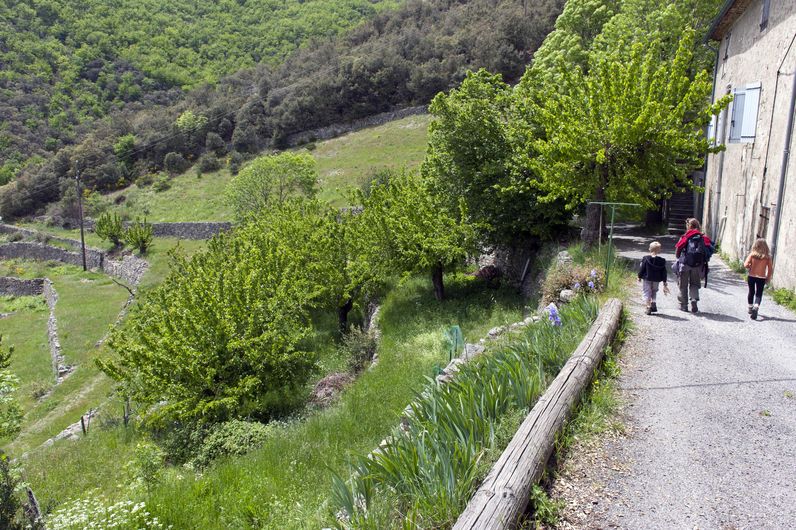
Mauripe
This southern part of the Cevennes is home to the historic mas (farms) and hamlets of Soudorgues, a region of religious resistance. The summit of Mauripe, less than 20 km as the crow flies from the peak of Mont Aigoual, overlooks them all, offering the visitor plunging 360° views.
7 points of interest

Aiguilles du pin parasol - Béatrice Galzin  Flora
FloraThe stone or umbrella pine
In the distance in the Lasalle valley there is dense, dark green vegetation. The stone or umbrella pine has a very characteristic opened-out shape, which resembles an umbrella from a distance. This conifer is at home especially in the Mediterranean basin. It prefers dry, deep and cool soils. Its bark is reddish and cracked. Its fruit, the pine nut, is often used in pastry cooking.
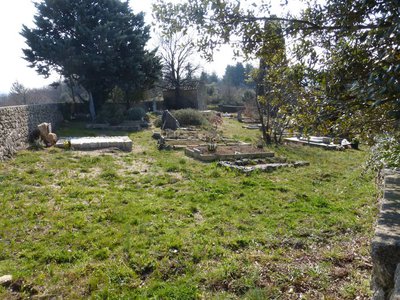
Cimetière communal - © Nathalie Thomas  History
HistoryCemetery history
The walk leads you past the village cemetery, which was in fact the Protestant cemetery. Soudorgues also has a Catholic cemetery, another particularity brought about by the turbulent history of the Reformation. Catholic cemeteries did not accept “non-Christians” or “heretic Christians”. There were countless exhumations of Protestant bodies in the 16th century. To put an end to this injustice, the Edict of Nantes ordered that “convenient” cemeteries be built for those who followed the so-called reformed religion. When the Edict was revoked, the order was also dropped. Huguenots had to renounce their religion to be buried in 'family” cemeteries in the countryside. Today, only the owners of these on-site cemeteries still have the right to be buried in them.

 Know-how
Know-howLime kiln
The process of burning limestone to make lime has been used since the Bronze Age. The lime was mixed with sand to make mortar for building houses. Concrete was not known until the early 19th century. Lime is also a powerful antiseptic and was used to disinfect buildings, especially sheepfolds. The kiln operator had to maintain the kiln temperature at 800 to 1,000°C. Plaster was made from gypsum deposits using the same principle.

Vue des crêtes de Mauripe - © Olivier Prohin  Landscape
Landscape360° views from Mauripe
From here, on a clear day, you can see the Alps (west) and the Mediterranean (south). Looking northwest, you can make out Mont Aigoual, the Col de l'Asclier pass, the Col de Fageas with its television mast and, if you follow the ridges eastwards with your eyes, the Rocher de l'Aigle, Piécamp and La Mortière. The lowest ridge is the famous Corniche des Cevennes. Behind it, further east, are the mountain ranges of La Vieille Morte and Le Mortissou, and, in the far distance, the ridges of Mont Lozère. Far to the south, you can make out the city of Alès and, even further away, Mont Ventoux. In front are the town of Lassalle and then La Fage mountain above Saint-Hippolyte-du-Fort. On the horizon, the Mediterranean shimmers furtively.
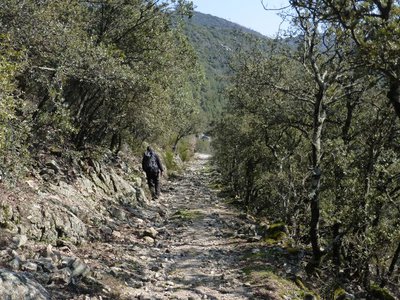
Descente au col de Mercou - © Nathalie Thomas AgricultureDraille
The rocky path becomes wider and has stone reinforcements on the downhill side, which shows that it was once used by large herds. This draille led from Saint-Jean-du-Gard to the summer pastures on Mont Aigoual. At the Col de Mercou pass (570 m), there are panoramic views northwards over the Corniche des Cevennes. The pass was once a site for trade and commerce, with its own market. Its name is derived from Mercury, the god of travellers and commerce. There are also references to Melkart, a Phoenician deity: Semitic traders left traces of their passage here in the architecture of the old proto-historic bridges. Melkart or Melqart was the tutelary god of the city of Tyre - whose name means “strong king” in Phoenician – and was the god of riches, industry and navigation. He was worshipped in the tenth century BC.
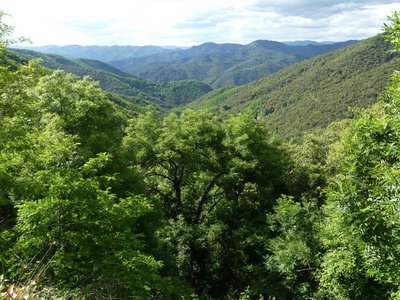
Les cachettes huguenotes - Nathalie Thomas  History
HistoryThe King’s dragoons and the dragonnade
Three-quarters of local Huguenots (Protestants) renounced their faith due to the “missionaries in boots”, meaning the dragoons. The dragonnade was the name given to Huguenots being forced to house these soldiers of the King, who then pillaged and mistreated them into renouncing their faith. The dragoons met with a unique resistance in the Camisard War (1702 to 1705), during which 3,000 Protestants in white shirts defied 30,000 red dragoons. The dragoons were on horseback, booted and armed with sabres a metre-and-a-half long, which was not very practical on small paths, during this guerilla war.
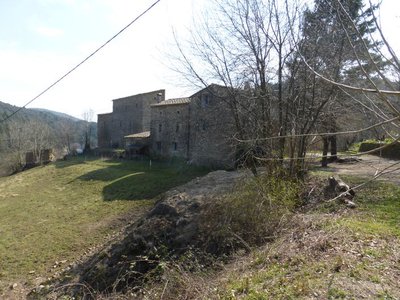
Le mas de Moina - © Nathalie Thomas  History
HistoryLes caches des prédicants
From 1685, the so-called “wilderness period” began for Protestants, who were forced to follow their faith with clandestine preaching in isolated spots. In the Soudorgues area, these included Villeméjeanne (called Campan), Les Bousquets, Espaze, La Faux and Grevault du Bedos (a mas or farm near the pass of the same name). They took refuge in caves or with locals. The Mas du Moina had several hiding-places. One, in the stables of the residential building, had an arrowslit to be able to see the Dragoons arrive. Near Soudorgues, hiding-places have been identified at Mas Novis, Euzière and Viala (in the hamlet of Horts). Their good-hearted inhabitants risked having their farms destroyed and being sent to the galleys for life. A little further, beyond Mas Guiraud, there is still a flat-topped rock known as Le Templas, which has a very narrow entrance. About 20 people could fit into it for religious gatherings.
Description
From the car park, head towards La Pierre Plantée / Mairie de Soudorgues via Les Quatre Chemins. Pass the mairie and then the temple (Protestant church). At the crossroads, turn left towards Col de Cabane Vieille / La Pierre Plantée. At the fork, continue towards Col de Cabane Vieille / Le Four à Chaux. The road leads to a hairpin bend. At the apex of the bend, a small path leads you to the lime kiln (do not enter the walled-in area – the site is dangerous). Take the GR63 long-distance hiking path on your left for about a hundred metres, then take the path on the right, which crosses to the other slope further on, to the rocks signposted Col du Mercou / Sous le Mauripe. Shortly afterwards, a signpost points left into the rocks Col du Mercou / Serre des Ubacs. This is where you start your climb to the summit of Mauripe. The path switches back and forth between the Salindrenque side and the Mercou side. At the top, take the path that winds left, then curves to the right. The descent, which is rather steep, leads to the Serre des Ubacs in a few minutes. Turn right towards Col du Mercou / Mercou. The path on which you return to Soudorgues / Les Quatre Chemins, forks off to the right towards Le Moina. Head back to the car park by following "Soudorgues / Mairie de Soudorgues".
- Departure : Soudorgues
- Arrival : Soudorgues
- Towns crossed : Soudorgues
Forecast
Altimetric profile
Recommandations
Make sure your equipment is appropriate for the day's weather conditions. Remember that the weather changes quickly in the mountains. Take enough water, wear good shoes and put on a hat. Please close all gates and barriers after yourself.
Information desks
Tourism office Mont Aigoual Causses Cévennes, Saint-André-de-Valborgne
les quais, 30940 Saint-André-de-Valborgne
This office is part of the National Park's associated tourist-information network, whose mission is to provide information on, and raise awareness of, the sites and events as well as the rules that must be observed in the National Park's central zone.
Access and parking
From Anduze, take the D 907 road towards St Jean du Gard, then the D 57 to Thoiras / Lasalle. Drive through Lasalle and Les Horts on the D 39, then turn off towards Soudorgues (D 271).
Parking :
Calculateur d'itinéraire Lio
Utilisez le calculateur liO pour organiser votre trajet en région Occitanie.
Autres régions
Calculez votre itinéraire en Auvergne Rhône Alpes sur Oùra
Biodiversité autour de l'itinéraire
Source

Report a problem or an error
If you have found an error on this page or if you have noticed any problems during your hike, please report them to us here:

